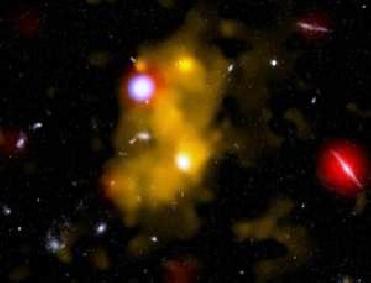
Large, glowing blobs of hydrogen gas (yellow) in the early universe seem to be lit by galaxies boasting gluttonous supermassive black holes (blue). Credit: NASA photo.
NEW DELHI (BNS): A new study has suggested that mysterious blobs of gas that dotted the early universe are actually lit by almost-full galaxies.
The gas cloud – which may conceal a galaxy – is known as a Lyman-alpha blob, named for a particular wavelength of light released when an electron loses energy in a hydrogen atom.
Masami Ouchi of the Observatories of the Carnegie Institution in Pasadena, California, and colleagues first spotted the gas in images of the deep sky taken with the Subaru Telescope in Mauna Kea in Hawaii.
Astronomers have puzzled over the power source behind vast reservoirs of glowing hydrogen gas that can span about 500,000 light years across, several times the size of our own Milky Way.
According to the new study, the clouds are actually lit by almost-full galaxies that prevent the gas from falling inwards. Here, supermassive black holes inside the galaxies are thought to be devouring their surroundings, spawning powerful outpourings of energy, the New Scientist report said.
“This energy, along with that radiated by abundant young stars in the galaxies, is thought to heat up nearby gas, causing it to glow as Lyman-alpha blobs. At the same time, this heat prevents the gas from cooling down and falling into the galaxies,” it said.
“This is a phase where the galaxies are nearly finished growing and are now trying to prevent further growth by stopping fresh gas from cooling ... basically a form of self-regulation,” said astronomer James Geach of Durham University in the UK.
Using the orbiting Chandra X-ray Observatory, Geach and his colleagues measured the X-ray light emanating from a patch of sky containing 29 Lyman-alpha blobs. “The blobs are so distant they appear to us as they were just 2 billion years after the big bang. It's possible that nearly all massive galaxies could go through a blob phase,” Geach said.
In the study, the blobs that did not glow brightly in X-rays were generally dimmer, suggesting that if they are associated with black holes, the holes' outbursts were too weak to be seen, the team said.
“If all young massive galaxies do go through a blob phase, it may be visible only briefly – perhaps for just a few hundred million years,” Geach added.
“We are seeing these objects at a stage when the gas is still present and is maximally conspicuous because it's being energised by the black hole and by stars,”said Martin Rees of the University of Cambridge, who was not affiliated with the study. “If you were to watch one of the blobs for the next one or two billion years, you would see the gas would either be blown away or it would turn into stars.”
 Previous Article
Previous Article Next Article
Next Article












The Indian Air Force, in its flight trials evaluation report submitted before the Defence Ministry l..
view articleAn insight into the Medium Multi-Role Combat Aircraft competition...
view articleSky enthusiasts can now spot the International Space Station (ISS) commanded by Indian-American astr..
view article